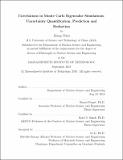Correlations in Monte Carlo eigenvalue simulations : uncertainty quantification, prediction and reduction
Author(s)
Miao, Jilang.
Download1134988792-MIT.pdf (7.615Mb)
Other Contributors
Massachusetts Institute of Technology. Department of Nuclear Science and Engineering.
Advisor
Benoit Forget and Kord S. Smith.
Terms of use
Metadata
Show full item recordAbstract
Monte Carlo methods have mostly been used as a benchmark tool for other transport and diffusion methods in nuclear reactor analysis. One important feature of Monte Carlo calculations is the report of the variance of the estimators as a measure of uncertainty. In the current production codes, the assumption of independence of neutron generations in Monte Carlo eigenvalue simulations leads to the oversimplified estimate of the uncertainty of tallies. The correlation of tallies between neutron generations can make reported uncertainty underestimated by a factor of 8 in assembly size tallies in a typical LWR. This work analyzes the variance/uncertainty convergence rate in Monte Carlo eigenvalue simulations and develops different methods to properly report the variance. To correct the underestimated variance as a post-processing step, a simple correction factor can be calculated from the correlation coefficients estimated from a sufficient number of active generations and fitted to decreasing exponentials. If the variance convergence rate is needed before or during the simulation to optimize the run strategy (number of generations and neutrons per generation), a discrete model can be constructed from the inactive generations that can predict the correlation behavior of the original problem. Since it is not efficient to perform variance correction to all tallies on all problems, a simple correlation indicator is also developed to quickly determine the potential impact of correlations on a given tally in a given problem. This can help decide if more complicated correction analysis or the use of independent simulations should be used to calculate the true variance. Run strategy to reduce correlations is also investigated by introducing the notion of delayed neutrons. A predictive model for the new source update scheme was developed to help identify optimal delayed neutron parameters before implementing in OpenMC. Optimal run strategies in terms of delayed bank size, frequency of delayed bank sampling and true simulation costs are proposed.
Description
This electronic version was submitted by the student author. The certified thesis is available in the Institute Archives and Special Collections. Thesis: Ph. D., Massachusetts Institute of Technology, Department of Nuclear Science and Engineering, 2018 Cataloged from student-submitted PDF version of thesis. Includes bibliographical references (pages 323-327).
Date issued
2018Department
Massachusetts Institute of Technology. Department of Nuclear Science and EngineeringPublisher
Massachusetts Institute of Technology
Keywords
Nuclear Science and Engineering.